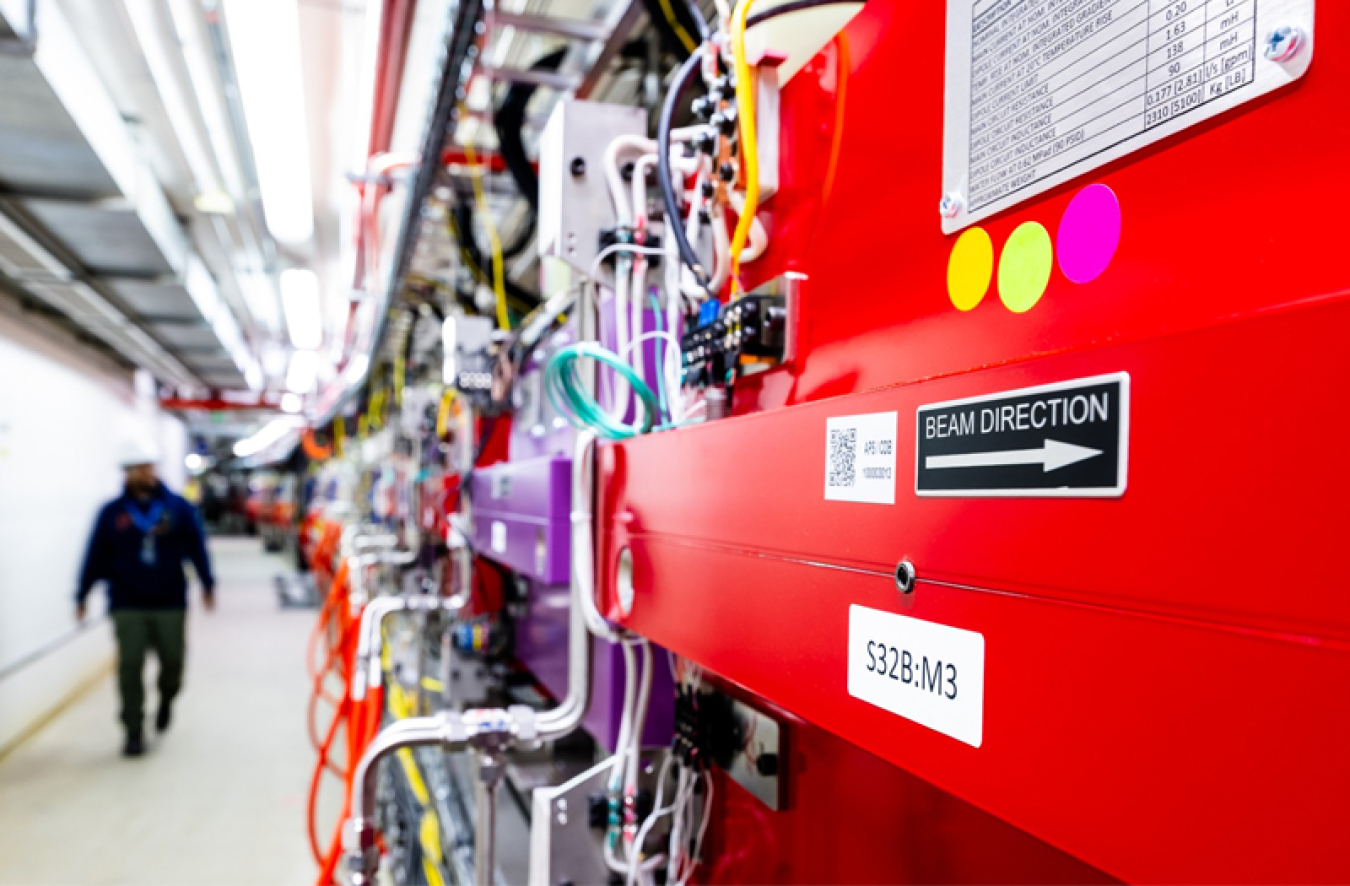The Advanced Photon Source at Argonne National Laboratory recently underwent an upgrade that will make it more powerful than ever before.
July 18, 2024
In our daily lives, we encounter X-rays most often when we go to the dentist for a checkup or a hospital for a broken bone. But scientists, technicians, and engineers who work on and with the Advanced Photon Source (APS) are familiar with a very different, much stronger type of X-ray beam. The Advanced Photon Source, a Department of Energy (DOE) Office of Science user facility, is a truly tremendous piece of scientific equipment. Bigger than Chicago’s Wrigley Field, it allows scientists incredible views into materials and how they work. Recently, the APS underwent a massive upgrade. The lab celebrated the upgrade with a ribbon cutting and dedication ceremony. With the upgrade, the X-ray beams will be hundreds of billions of times brighter than dental X-rays and up to 500 times brighter than the original facility.
The workings of the Advanced Photon Source
Starting in the 1940s, scientists used particle accelerators to smash together high energy particles. As they did so, the accelerators also put out very bright light. Over time, the scientists realized that the very bright light could be useful for peering inside of materials and understanding how they work. They learned how to harness that light for research via X-ray light sources. The APS is one of five DOE Office of Science light sources.
Light sources create beams of particles and then manipulate them to produce very bright X-ray beams. The APS uses bunches of electrons to form its beams. After a cathode produces the electrons, different parts of the machine then speed them up and compress them down. A key part, called the booster, uses powerful electromagnets to accelerate electrons up to 99.999999% the speed of light. Lastly, the electrons rotate around the storage ring. Here, the electrons move through vacuum chambers, where even more powerful electromagnets focus them into a narrow beam. The storage ring has 40 sections. The APS team uses five of those sections to inject the beam and manage the equipment. The other 35 can be used for experimental stations where scientists conduct research using the beam. Because each sector can support multiple experiment stations simultaneously, it’s the equivalent of dozens of separate labs in one location. The APS has over 70 X-ray beamlines.
Upon its launch in 1996, the APS immediately became a cutting-edge facility in X-ray science. It provides X-ray beams to more than 5,500 researchers a year. Its ability to act as a giant, three-dimensional microscope allows scientists to gain detailed information about chemical processes and materials. It’s particularly useful for scientists to gain insights into interfaces where materials meet, which is essential for understanding how to design and use new materials.
Accomplishments of the APS
Scientists have used the APS to delve deep into many scientific questions, ranging from the fundamentals of our universe to improvements in solar cells. In fact, the APS enabled research that won Nobel Prizes.
The 2009 prize in chemistry recognized three different scientists for their discoveries about how ribosomes work. Ribosomes are the machinery that produce proteins in cells. Ada E. Yonath conducted her research with the help of the APS, while the other two researchers used other DOE X-ray light sources.
The 2012 Nobel Prize in chemistry also focused on human biology. This time, the award was for work on human G-protein-coupled receptors. These are proteins in cells’ membranes that detect molecules outside of the cell and trigger responses. Besides being a fundamental part of biology, about half of today’s pharmaceuticals work by connecting with one or more of these receptors. Understanding these proteins’ structure is key to developing effective drugs. The APS provided a stable, intense, small-area beam that allowed scientists to map the structure of a receptor in a human cell. They also documented how these receptors send signals that trigger responses in cells.
More recently, the APS was an essential tool for both developing vaccines for COVID-19 and medications for patients with COVID-19. Other accomplishments include establishing the foundational science for lithium-ion batteries that many electric vehicles use and revealing new information about Earth’s early atmosphere.
Upgrading a legend
With the new upgrade, the APS will be able to do more than ever before. But upgrading a machine of this size and complexity is a difficult, complicated job. Argonne National Laboratory started planning this upgrade about a decade ago! In 2023, they paused research to begin construction.
Most of the work was dedicated to replacing the massive storage ring and installing a brand-new one. As this is the section that generates the X-ray beams, upgrading it makes a huge difference. The new ring is made up of 200 modules as well as thousands of associated components and systems.
One of the biggest changes to the storage ring is altering the method by which it replenishes bunches of electrons. This new method is called swap-out. Part of running an X-ray light source is dealing with the fact that electron beams get weaker as they circulate around the storage ring. As the beam moves, electrons scatter, which dims the beam. The standard way of solving this problem is to inject more electrons, effectively “topping up” beams. In fact, the APS team developed this technique in the 1990s! However, aspects of the upgrade render this technique impractical. So the APS team had to once again come up with a solution. Instead of only injecting in new electrons, the technique kicks out a set of electrons, then dumps new ones in, all within a few nanoseconds. To ensure the beam is consistent, it repeats this process every five to 30 seconds. The APS will be the first modern tool of its kind in the world to use this technology.
Once the team had installed the new equipment, they began the process of commissioning. That process included circulating electrons in the ring, which happened in April 2024. While the first test only had the electrons circulate around the ring once, the beam circulated more than a dozen times the next day. That was a huge milestone. For the beam to circulate without issues, the ring must be as close to perfect and spotless as is physically possible. Any obstruction, misalignment, or shift in power supply will throw off the beam.
First light and more
With all of the testing complete, the upgraded APS experienced its first light on June 17, 2024! Once it is fully launched, it will produce the world’s brightest “hard” X-rays. Hard X-rays have higher energy and can penetrate materials more thoroughly than so-called “soft” X-rays. These changes will allow scientists to see shifts at the molecular level in real time even more closely.
The upgraded APS delivered its first X-ray light beams to a scientific beamline called 27-ID. This experimental station allows scientists to study how the valence electrons – the ones on the furthest edges of atoms – behave. These electrons govern how atoms bond and react to each other as well as influence materials’ electrical and magnetic properties. With upgrades to the beamline itself as well as to the whole APS, scientists will be able to study phenomena important for advanced batteries and quantum computing.
The team is now in the process of bringing the other 70 experimental stations back into operation. They expect scientists to resume their research by the end of the year. While we can’t fully predict discoveries, it’s a good bet that the upgraded APS will enable even more groundbreaking science essential to new technologies and a deeper understanding of our world.
Shannon Brescher Shea

Shannon Brescher Shea ([email protected]) is the social media manager and senior writer/editor in the Office of Science’s Office of Communications and Public Affairs. She writes and curates content for the Office of Science’s Twitter and LinkedIn accounts as well as contributes to the Department of Energy’s overall social media accounts. In addition, she writes and edits feature stories covering the Office of Science’s discovery research and manages the Science Public Outreach Community (SPOC). Previously, she was a communications specialist in the Vehicle Technologies Office in the Office of Energy Efficiency and Renewable Energy. She began at the Energy Department in 2008 as a Presidential Management Fellow. In her free time, she enjoys bicycling, gardening, writing, volunteering, and parenting two awesome kids.

